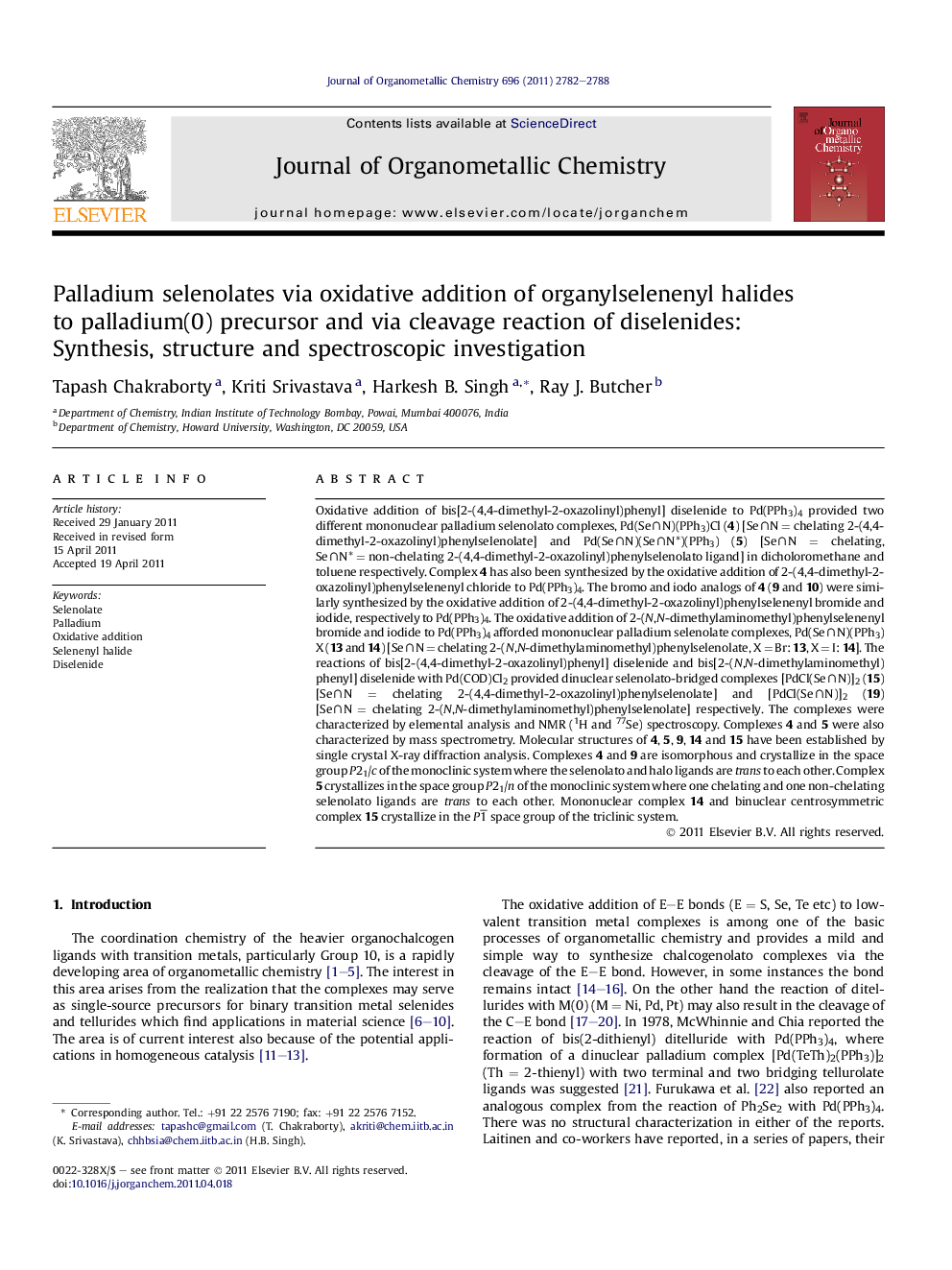| کد مقاله | کد نشریه | سال انتشار | مقاله انگلیسی | نسخه تمام متن |
|---|---|---|---|---|
| 1323960 | 1499938 | 2011 | 7 صفحه PDF | دانلود رایگان |

Oxidative addition of bis[2-(4,4-dimethyl-2-oxazolinyl)phenyl] diselenide to Pd(PPh3)4 provided two different mononuclear palladium selenolato complexes, Pd(Se∩N)(PPh3)Cl (4) [Se∩N = chelating 2-(4,4-dimethyl-2-oxazolinyl)phenylselenolate] and Pd(Se∩N)(Se∩N*)(PPh3) (5) [Se∩N = chelating, Se∩N* = non-chelating 2-(4,4-dimethyl-2-oxazolinyl)phenylselenolato ligand] in dicholoromethane and toluene respectively. Complex 4 has also been synthesized by the oxidative addition of 2-(4,4-dimethyl-2-oxazolinyl)phenylselenenyl chloride to Pd(PPh3)4. The bromo and iodo analogs of 4 (9 and 10) were similarly synthesized by the oxidative addition of 2-(4,4-dimethyl-2-oxazolinyl)phenylselenenyl bromide and iodide, respectively to Pd(PPh3)4. The oxidative addition of 2-(N,N-dimethylaminomethyl)phenylselenenyl bromide and iodide to Pd(PPh3)4 afforded mononuclear palladium selenolate complexes, Pd(Se∩N)(PPh3)X (13 and 14) [Se∩N = chelating 2-(N,N-dimethylaminomethyl)phenylselenolate, X = Br: 13, X = I: 14]. The reactions of bis[2-(4,4-dimethyl-2-oxazolinyl)phenyl] diselenide and bis[2-(N,N-dimethylaminomethyl)phenyl] diselenide with Pd(COD)Cl2 provided dinuclear selenolato-bridged complexes [PdCl(Se∩N)]2 (15) [Se∩N = chelating 2-(4,4-dimethyl-2-oxazolinyl)phenylselenolate] and [PdCl(Se∩N)]2 (19) [Se∩N = chelating 2-(N,N-dimethylaminomethyl)phenylselenolate] respectively. The complexes were characterized by elemental analysis and NMR (1H and 77Se) spectroscopy. Complexes 4 and 5 were also characterized by mass spectrometry. Molecular structures of 4, 5, 9, 14 and 15 have been established by single crystal X-ray diffraction analysis. Complexes 4 and 9 are isomorphous and crystallize in the space group P21/c of the monoclinic system where the selenolato and halo ligands are trans to each other. Complex 5 crystallizes in the space group P21/n of the monoclinic system where one chelating and one non-chelating selenolato ligands are trans to each other. Mononuclear complex 14 and binuclear centrosymmetric complex 15 crystallize in the P1¯ space group of the triclinic system.
A set of mononuclear palladium selenolato complexes have been synthesized by the oxidative addition of 2-(4,4-dimethyl-2-oxazolinyl)phenylselenenyl chloride, bromide and iodide and 2-(N,N-dimethylaminomethyl)phenylselenenyl bromide and iodide to Pd(PPh3)4. Also the reactions of bis[2-(4,4-dimethyl-2-oxazolinyl)phenyl] diselenide and bis[2-(N,N-dimethylaminomethyl)phenyl] diselenide with Pd(COD)Cl2 provided dinuclear selenolato-bridged complexes [PdCl(Se∩N)]2 [Se∩N = chelating 2-(4,4-dimethyl-2-oxazolinyl)phenyl selenolate and chelating 2-(N,N-dimethylaminomethyl)phenyl selenolate] respectively.Figure optionsDownload as PowerPoint slideHighlights
► First instance of oxidative addition of RSeX (X = Cl, Br, I) to Pd(0).
► Mononuclear Pd-selenolate complexes from the oxidative addition of RSeX to Pd(0).
► Dinuclear Pd-chalcogenolates by the cleavage of R2E2 (E = Se, Te) with Pd(II).
Journal: Journal of Organometallic Chemistry - Volume 696, Issues 15–16, 1 August 2011, Pages 2782–2788